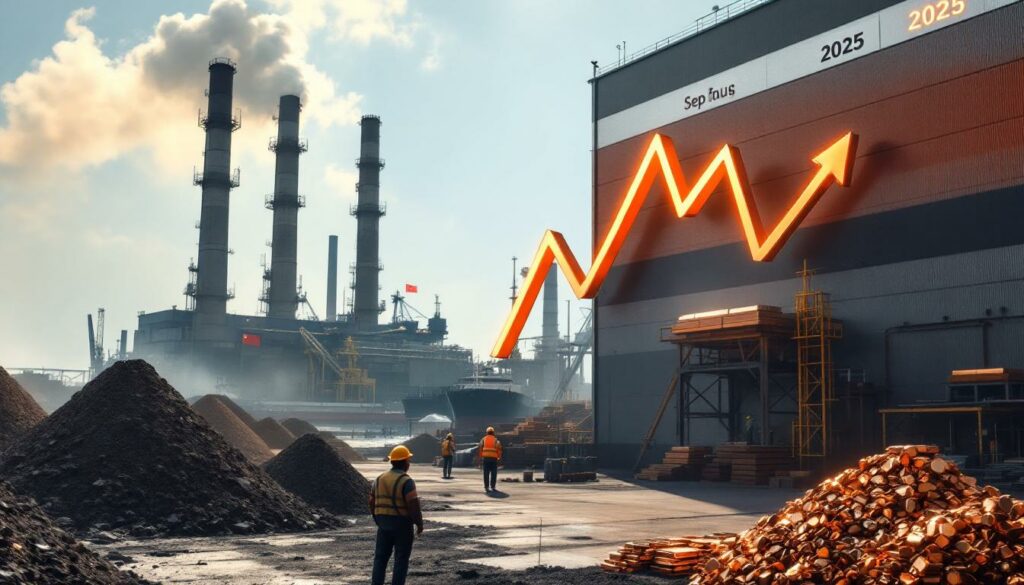What's Causing China's Copper Smelters to Cut Production?
After months of defying economic gravity, China's copper smelters are finally facing a reckoning. According to Shanghai Metals Market's (SMM) monthly survey, Chinese copper smelters are projected to reduce output by 0.5% in August 2025 from July's record-breaking production levels, with further declines anticipated in September.
This marks a significant turning point for the world's largest copper refining market, which has maintained production growth despite increasingly challenging conditions. The persistent raw material shortages that have been looming on the horizon are now making a tangible impact on operations.
"The feedstock crisis that analysts have been warning about for quarters is finally materializing in production numbers," notes industry analyst Wei Chen. "Chinese smelters have been operating in an increasingly unsustainable environment, and we're seeing the first cracks in the system."
The Emerging Feedstock Crisis
At the heart of this production slowdown lies a fundamental mismatch between China's vast smelting capacity and the available copper concentrate supply. The country's smelters have expanded aggressively in recent years, outpacing global mining output growth and creating intense competition for raw materials.
Treatment and refining charges (TC/RCs) – the fees smelters charge miners to process copper concentrate into refined metal – have been severely depressed for extended periods, reflecting this imbalance. However, there are early signs of a potential shift in market dynamics.
According to the South China Morning Post (August 4, 2025), spot treatment fees "have turned higher over the past month, indicating that smelters may have begun to better align their capacity with the availability of ore." This modest improvement from extreme lows suggests that capacity adjustments are beginning to rebalance the market.
The official July 2025 production figures, scheduled for release on August 18, 2025, will provide additional clarity on the extent of this emerging trend. Industry analysts will be watching these numbers closely for confirmation of the projected slowdown.
Market Implications of China's Dominance
The global significance of these developments cannot be overstated. China currently accounts for over half of the world's refined copper production, making any fluctuations in its output "highly consequential for the market," as reported by the South China Morning Post.
This outsized influence means that even a modest 0.5% production cut translates to significant tonnage in absolute terms. With August 2025 production projected at 1.168 million tonnes (down from July's peak), the reduction represents thousands of tonnes of refined copper removed from global supply chains.
What makes this shift particularly noteworthy is that it comes after Chinese smelters maintained remarkable production resilience despite poor economics. While their international counterparts began implementing production cuts earlier, Chinese operations – many enjoying state backing – continued expanding output to achieve "a succession of record highs in recent months."
This production discipline, if sustained, could help rebalance the global copper market that has been distorted by China's ability to operate smelters at losses that would be unsustainable for most commercial enterprises. Furthermore, investors should carefully monitor these developments as they could significantly impact copper price insights in the coming months.
How Did China's Copper Smelting Capacity Reach This Point?
The current predicament facing China's copper smelters ore shortage has its roots in an expansionary strategy that prioritized capacity growth even as warning signs mounted.
Rapid Expansion Despite Market Signals
For years, Chinese smelters have consistently increased production capacity despite what the South China Morning Post describes as "tight feedstock markets and cratering profitability." This counterintuitive expansion occurred while clear market signals indicated the need for restraint.
The growth trajectory persisted through three significant headwinds:
- Persistent concentrate shortages: Global copper mining has struggled to keep pace with China's refining capacity additions
- Depressed treatment charges: TC/RCs remained at levels that made profitable operations challenging for many smelters
- International cutbacks: Non-Chinese smelters began reducing production in response to economic realities
Despite these challenges, state support enabled many Chinese operations to continue expanding while international competitors scaled back. This resulted in successive monthly production records through July 2025, creating an increasingly unsustainable market dynamic.
The pattern mirrors broader industrial trends across Chinese manufacturing sectors, where capacity growth has often continued regardless of profitability or market signals. This approach has contributed to deflationary pressures in multiple industries and has significantly impacted the global copper supply forecast for years to come.
The Economics of Copper Smelting in China
The financial realities of copper smelting in China reveal an industry operating on increasingly thin margins – or in many cases, significant losses. Treatment and refining charges have remained depressed for extended periods, undermining the core economics of the smelting business model.
Smelters typically generate revenue primarily through:
- TC/RCs charged to miners for processing concentrate
- The recovery of precious metal by-products
- Price premiums for cathode over exchange prices
With the first revenue stream severely constrained by low TC/RCs, many facilities have been operating at significant losses for sustainability reasons. As one industry insider noted off the record, "Some operations have been running at technical insolvency levels for quarters, sustained only by local government support or integration benefits with upstream or downstream operations."
State-backed operations have demonstrated greater resilience than private or international competitors, with access to preferential financing, energy pricing, and other forms of indirect support. However, even these advantages have limits when faced with persistent raw material shortages.
Why Is The Chinese Government Concerned About Copper Overcapacity?
The emerging production cuts align with a broader shift in Chinese economic policy that is increasingly prioritizing sustainable growth over volume-based metrics.
Broader Economic Policy Shifts
China's government is intensifying its campaign against industrial overcapacity across multiple sectors, including metals production. This represents a significant pivot from previous approaches that often encouraged capacity growth regardless of market conditions.
The South China Morning Post notes "greater urgency among policymakers to fix the ruinous competition and overproduction driving deflationary pressures in the economy." This policy shift recognizes that unchecked expansion in industries like copper smelting creates systemic economic challenges that extend far beyond the sector itself.
Deflationary pressures have emerged as a key concern for Chinese economic planners, with excess capacity in manufacturing contributing to price pressures that complicate broader economic management. Copper industry overcapacity exemplifies this problem, creating market distortions that ultimately undermine economic stability.
The concept of "ruinous competition" has gained increasing prominence in policy discussions, acknowledging that when too many producers chase limited raw materials or customers, the resulting economic dynamics become destructive rather than productive. Additionally, these trends have led to a notable copper price retreat analysis that many market observers are closely following.
Balancing Industrial Policy and Market Forces
Chinese authorities are now seeking to better align production capacity with raw material availability across multiple industrial sectors. This marks an important evolution in the country's approach to industrial development.
The overcapacity issues extend beyond copper to other industrial metals and manufacturing sectors, creating systemic challenges for economic planners. Production rationalization has become increasingly urgent for maintaining economic stability and achieving sustainable growth.
Government policies now encourage consolidation rather than expansion, with incentives shifting to reward efficiency and sustainability over raw production volume. This recalibration represents a significant maturation in China's industrial policy approach.
For the copper industry specifically, this means encouraging smelters to make realistic assessments of concentrate availability and adjust capacity utilization accordingly. The goal is to create a more sustainable balance between refining capacity and raw material supply.
What Are the Global Implications of China's Copper Production Challenges?
The emerging production cuts in China are likely to have far-reaching implications for the global copper market, potentially rebalancing supply chains that have been distorted by China's outsized influence.
International Market Responses
Non-Chinese smelters have already implemented production cuts due to ore shortages, unable to sustain operations at the low treatment charges that Chinese facilities could tolerate. As the Bloomberg reports, "Some overseas rivals, which lack the state backing enjoyed by many Chinese operators, have already begun to curtail production."
If Chinese cuts materialize as projected, the global copper concentrate market is likely to rebalance more quickly than previously anticipated. This would create a positive feedback loop where reduced competition for concentrate leads to improving treatment charges, which in turn enables more sustainable operations for remaining producers.
Treatment charges are expected to continue their recovery from historically low levels, potentially returning to ranges that support profitable operations for efficient smelters. This normalization would benefit the entire industry by restoring more sustainable economics.
The potential for improved profitability across global smelting operations could also encourage investment in maintenance and efficiency improvements that have been deferred during the prolonged period of margin pressure.
Supply Chain Considerations
Refined copper plays a critical role in the global transition to renewable energy and electrification, making any supply disruptions potentially significant for downstream industries. Production cuts could create supply constraints for copper-intensive manufacturing sectors like electronics and electric vehicles.
The supply implications are particularly relevant given copper's status as a critical mineral for:
- Renewable energy infrastructure: Solar and wind power systems
- Electric vehicle production: Motors, wiring, and charging infrastructure
- Power grid modernization: Transmission and distribution equipment
- Electronics manufacturing: Circuit boards and components
Import dependencies may shift as domestic Chinese production adjusts to feedstock realities, potentially creating new opportunities for international producers able to fill supply gaps. Countries with substantial smelting capacity but insufficient mining output may need to recalibrate their supply chain strategies.
The production adjustments also raise important questions about price implications. While reduced output typically supports higher prices, the complex interplay between concentrate availability, smelting capacity, and rising copper demand makes outcomes difficult to predict with certainty.
How Are Chinese Smelters Adapting to Changing Market Conditions?
Faced with persistent raw material shortages and changing policy signals, Chinese copper smelters are beginning to implement adaptation strategies that mark a departure from their previous expansion-focused approach.
Operational Strategies
The first signs of adaptation are visible in capacity utilization decisions. As indicated by the South China Morning Post, smelters "may have begun to better align their capacity with the availability of ore" – a fundamental shift from the previous approach of maximizing production regardless of economic signals.
This realignment is taking several forms:
- Maintenance scheduling optimization: Extending planned outages to reduce concentrate requirements
- Selective line idling: Temporarily suspending less efficient production units
- Feed mix adjustments: Modifying concentrate blends to accommodate available materials
- Operational efficiency improvements: Enhancing recovery rates to maximize output from limited feedstock
Some facilities are exploring increased use of recycled copper (scrap) to reduce their dependence on concentrate. While technical limitations constrain this approach – particularly for facilities designed primarily for concentrate processing – it offers a partial mitigation strategy for raw material shortages.
Technological improvements to enhance recovery rates from lower-grade materials are also receiving increased attention. Innovations in flotation, leaching, and electrowinning processes can help extract more metal from challenging feed materials, though implementation requires capital investment that has been constrained by poor profitability.
Industry Consolidation Potential
The emerging production discipline creates conditions favorable for industry consolidation, with smaller, less efficient smelters most vulnerable to production curtailments or closure. Facilities with higher operating costs, outdated technology, or limited scale find themselves increasingly exposed as market conditions tighten.
Larger state-backed entities are positioned to acquire struggling operations, potentially accelerating the sector's consolidation. This would align with broader government objectives to rationalize industrial capacity while maintaining strategic control of critical industries.
The potential for coordinated industry-wide production discipline is increasing, whether through formal mechanisms or informal alignment of interests. As capacity utilization normalizes, Chinese smelters may find themselves with an improved bargaining position with international miners, potentially supporting more sustainable treatment charges.
This consolidation phase, if it materializes as expected, would represent a natural maturation of an industry that has experienced rapid but sometimes chaotic growth. The resulting landscape would likely feature fewer but stronger players operating more sustainable business models aligned with effective copper investment strategies.
What Does the Data Tell Us About China's Copper Industry Trends?
The statistical evidence supports the narrative of an industry at an inflection point, with key metrics suggesting that the era of unconstrained expansion may be ending.
Production Metrics and Forecasts
According to Shanghai Metals Market's survey, August 2025 production is projected at 1.168 million tonnes. This represents a modest but significant 0.5% decline from July 2025, which represented the all-time peak production level before the current decline.
September 2025 is expected to show continued production decreases, potentially establishing a new trend after years of consistent monthly production increases. This reversal is particularly notable given the industry's previous resilience in maintaining output growth despite challenging economic conditions.
The historical trend of production increases "defying tight feedstock markets and cratering profitability" appears to be giving way to a more rational approach that acknowledges resource constraints and economic realities.
Official July 2025 production figures, scheduled for release on August 18, will provide an important reference point for understanding the magnitude of the peak before the projected decline. These statistics will be closely scrutinized for confirmation of the changing trend.
Profitability and Treatment Charge Indicators
Treatment charges are beginning to recover from severely depressed levels, offering a potential lifeline to smelters that have operated with compressed margins for extended periods. Spot processing fees have turned higher over the past month after a prolonged decline, suggesting improved bargaining power for smelters.
Despite these recent improvements, most smelters still operate below break-even economics. The relationship between capacity utilization and treatment charge recovery is becoming increasingly evident, with early signs that reduced competition for concentrate is allowing fees to normalize.
The data suggests a potential virtuous cycle where:
- Production cuts reduce competition for concentrate
- Reduced competition allows treatment charges to rise
- Improved treatment charges support better smelter economics
- Better economics enable sustainable operations at appropriate capacity levels
This rebalancing, if sustained, could help restore the copper industry to more sustainable economics after years of distortion driven by China's capacity growth.
FAQ: China's Copper Smelting Industry
How significant is China in global copper refining?
China accounts for more than half of the world's refined copper production, making any changes in its output levels globally significant for supply, pricing, and market dynamics. This dominant position has developed over the past two decades as China invested heavily in smelting capacity to support its manufacturing industries.
What are treatment charges and why do they matter?
Treatment charges (TCs) are fees that smelters charge miners to process copper concentrate into refined metal. These charges, typically expressed in dollars per tonne of concentrate processed, form a crucial revenue stream for smelters. Rising charges typically indicate improved bargaining power for smelters due to greater concentrate availability relative to processing capacity.
Refining charges (RCs), a related fee calculated as cents per pound of copper in the concentrate, work similarly. Together, TC/RCs function as a barometer of the balance between mining output and smelting capacity globally.
How does copper recycling factor into China's production?
Recycled copper (scrap) provides an alternative feedstock that can partially offset concentrate shortages. China has increasingly turned to scrap imports and domestic recycling to supplement primary production. However, high-quality scrap availability also faces constraints due to competition from other markets and quality challenges.
Scrap processing requires different equipment and processes than concentrate smelting, limiting the ability of many facilities to rapidly shift their feed mix. Facilities designed for concentrate processing can typically accommodate only a limited percentage of scrap in their feed without significant modifications.
What impact might production cuts have on copper prices?
Reduced Chinese production could potentially support higher copper prices if demand remains stable, though the relationship depends on global economic conditions and downstream consumption patterns. The impact would likely be most pronounced if production cuts coincide with continued strong demand from sectors like renewable energy and electric vehicles.
However, copper prices are influenced by multiple factors beyond just Chinese smelter output, including:
- Global economic growth trends
- Infrastructure spending patterns
- Renewable energy deployment rates
- Overall mining output
- Macroeconomic factors like interest rates and currency values
This complexity makes direct price predictions challenging, though reduced supply would generally be expected to provide price support, all else being equal.
Disclaimer: This article contains analysis of market trends and industry developments that may involve forecasts and speculation. Readers should conduct their own research and consult with financial advisors before making investment decisions based on the information presented. Market conditions can change rapidly, and future outcomes cannot be predicted with certainty.
Wondering How to Stay Ahead of Major Mineral Discoveries?
Discovery Alert's proprietary Discovery IQ model delivers instant notifications on significant ASX mineral discoveries, transforming complex data into actionable investment insights. Explore the potential returns from historic mineral discoveries on our dedicated discoveries page and gain your market-leading edge with a 30-day free trial.




